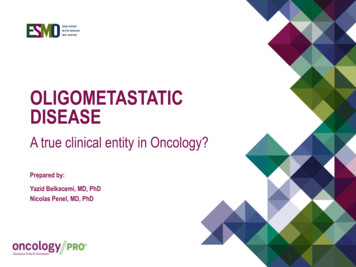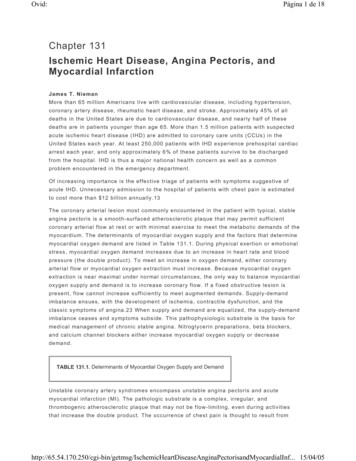
Transcription
OLIGOMETASTATICDISEASEA true clinical entity in Oncology?Prepared by:Yazid Belkacemi, MD, PhDNicolas Penel, MD, PhD
DISCLOSURESYazid Belkacemi has reported no conflicts of interestNicolas Penel has reported no conflicts of interest
AGENDA1.Definitions2.Biology of oligometastatic disease3.Best available evidence4.Role of stereotactic ablative radiotherapy (SABR)5.Future directions6.Take-home messages
AGENDA1.Definitions2.Biology of oligometastatic disease3.Best available evidence4.Role of stereotactic ablative radiotherapy (SABR)5.Future directions6.Take-home messages
DEFINITIONS There is no consensus on the definition of oligometastasis A generic definition is available However, we have to tailor the definition, at least, according to:the topic of “detectable” metastasisthe time interval between diagnosis of primary and diagnosis of oligo-metthe nature of the primary tumour
GENERIC DEFINITION1995 - Hellman S and Weichselbaum RR (JCO 1995) Patients with a limited number of clinically detectable metastatic tumours Hypothetic transitional state between localised and widespread systemic disease Local control of oligometastasis could delay (or avoid) the systemic spreading ?Oligometastasis Metastatic state with limited burden 1 to 5 metastasis
Widely metastatic disease limited metastatic disease( 5 )EDITORIALOligometastasesCancer treatment is based on an often unstated paradigm ofdisease pathogenesis. Since 1894, when W.S. Halstedclearly elucidated a mechanism of breast cancer spread andused it to design and support the radical mastectomy,surgical and radiotherapeutic approaches to most cancershave been based on this theory. The Halsted theoryproposed that cancer spread is orderly, extending in acontiguous fashion from the primary tumor through thelymphatics to the lymph nodes and then to distant sites.Radical en bloc surgery, such as radical neck dissection incontinuity with removal of the primary tumor, radicalhysterectomy, and primary and regional irradiation for avariety of tumor sites are all based on this notion of cancerspread.Hellman S & Weichselbaum RR, J Clin Oncol 1995Once tumors become invasive, they may gradually acquirethe properties necessary for efficient and widespreadmetastatic spread. Therefore the likelihood, number, andeven sites of metastases may reflect the state of tumordevelopment. This suggests that there are tumor satesintermediate between purely localized lesions and thosewidely metastatic. Such clinical circumstances are notaccounted for by either the contiguous or the systemichypotheses. The systemic hypothesis s binary: metastaseseither do or do not exist. If present, even if microscopic,they are extensive and widespread.
DEFINITIONTWO DIFFERENT ENTITIES1. “True” oligometastatic disease as initially defined, with relative steady-state andslowly growing disease. In this case, local control of oligomet makes sense2. “False” oligometastatic disease. In this case the occult systemic spreading isongoing, but a limited number of metastatic sites are detectable. In this case,systemic treatment is needed3. Does “True” Oligometastatic disease need confirmation at later time point?
DEFINITION LIMITS“Detectable” metastasis depends on the detection method sensitivityClinical exam onlyNobody agrees to define oligomet based on clinical exam only!Classical CT-Scan“Modern” (functional) imaging? Example of Prostate Cancer: what is the ideal method for definingoligometastasis?Whole body MRI(CT)-TEP: 18-FDG TEP, PMSA-TEP, FNA-TEP, Choline-TEPCombination of these methods?
DEFINITION ACCORDING TO THECONTROL OF PRIMARYConceptsDefinitionOligorecurrenceLimited metastases in the presence of a treated (controlled) primarylesionSync-oligometastases 5 metastatic or recurrent lesions in the presence of untreated(uncontrolled) primary tumourSynchronousoligometastasisOligometastatic disease is detected at the time of diagnosis of theprimary tumour, therefore there is an untreated (uncontrolled)primary tumourMetachronousoligometastasisDevelopment of oligometastatic disease after treatment of theprimary tumour; interval for classification of metachronous versussynchronous is not standardised; between controlled primary lesionexcept for concomitant primary and distant recurrence
TAILORED DEFINITION BYTUMOUR TYPE ?Items that could be included in a tailored definitionNumber of met detected by the ideal method?Taken into account the natural history of the disease?Taken into account the available method for treating oligometastasis?Taken into account previously done treatment?Including the “aim” of local treatment of oligometastasisCure the patient?Avoid or delay the starting of systemic treatment?
TAILORED DEFINITION BYTUMOUR TYPE?Proposed definitions for oligometastatic prostate cancerDefinition 1 - (Reeves F, BJU Int 2014)Rising PSA following primary therapy, with oligometastasis on imaging, in which localtreatment (surgical metastasectomy (usually lymph node – LN - dissection), or SBRTfor bony mets or lymph node recurrence) is required to defer initiation of androgendeprivation therapyDefinition 2 - (Reeves F, BJU Int 2014)Castrate resistant prostate cancer with a rising PSA and oligometastasis on imaging, inwhich local treatment (surgical metastasectomy (usually LN dissection), or SBRT forbony mets or LN recurrence) may allow deferral of androgen deprivation therapy
AGENDA1.Definitions2.Biology of oligometastatic disease3.Best available evidence4.Role of stereotactic ablative radiotherapy (SABR)5.Future directions6.Take-home messages
BIOLOGY OF OLIGOMETASTASIS2 protagonistsA – Tumour Example of colorectal cancerExample of clear cell renal cancerB – Host (patient)
BIOLOGY OF OLIGOMETASTASISBasically, 2 protagonistsA – Tumour Example of colorectal cancerExample of clear cell renal cancerB – Host (patient)Gene polymorphismImmune system ?
BIOLOGY OF OLIGOMETASTASISOligometastatic versus systemic disease: key-factorsOligometastaticdiseaseSystemic diseasePrimary tumourFavourablemicroenvironmentPoor conditions creatingundifferentiated aggressiveclonesSead (migrating cells)Sloughed cancer cellsActively migrating cellsSoils (target organs)Inhospitable targetorgans (trap)Hospitable target organs
LIVER MET. FROM CRC 134 patients with resected liver oligometastasis from colorectal cancers61% with only 1 met; 22% with 2 met. and 17% with 3 or more metMethodsWhole genome RNA sequencing of 95 samplesMicrosatellite instability analysis in 89 samples Identification of 3 molecular sub-types with different outcomesLow-risk group: 10 year-OS 94%Intermediate group: 10-year OS 45%High-risk group: 10-year OS 19% Pitroda SP, et al. Nature Comm 2018; 9(1): 1793 DOI: 10.1038/s41467-018-04278-6.
LIVER MET. FROM CRCPitroda SP, et al. Nat Commun 2018;9:1793, DOI: 10.1038/s41467-018-04278-6, licensedunder a Creative Commons Attribution 4.0 International /.
LIVER MET. FROM CRCSubtype 1CanonicalSubtype 2ImmuneSubtype 3StromalFrequency33%29%39%Molecular signature Immune and stroma ImmuneE2F/MYC signalingInterferon signalingDNA damage andp53 pathwaycell cycle StromaKRAS signalingEMT andangiogenesisSpecific mutationsNOTCH1 andPIK3C2BNRAS, CDK12,and EBF1MAD3Met. reccurencesManyFewManyOverall survivalIntermediateFavorableUnfavourablePitroda SP, et al. Nature Comm 2018; 9(1): 1793 DOI: 10.1038/s41467-018-04278-6.
CLEAR CELL RENAL CANCER 100 clear cell renal cancer – Evolutionary study of gene alterations in primarytumour and subsequent metastasis biopsy(ies)Validation on independent cohortsLoss of 9p21.3 is associated with poor outcomeDiffuse metastatic patternDeath caused by CCRC (p 0.0014)Distinct patterns of metastases are associated with some molecular signature rapidspreading versus oligometastasisTurajlic S, et al. Cell 2018; 173:581-94.
CLEAR CELL RENAL CANCER Distinct patterns of metastases are associated with some molecular signaturesRapid spreading versus oligometastasisRapid spreading is associated withLoss of 9p21.3VHL wild typeBAP1 mutationLow intra-tumoural heterogeneity and high chromosomal complexity Turajlic S, et al. Cell 2018; 173:581-94.
BIOLOGY OF OLIGOMETASTASIS:WHAT ABOUT HOST ? Metastatic spreading is associated with some polymorphismsCase-control study of patient with carcinoma of unknown primary (by definition,systemic bulky metastatic disease) – genome-wide association study At least, 8 polymorphisms are associated with CUP diagnosis (p 10-6)rs2660852 located closed to LTAH4H gene (leukotriene A4 hydrolase)rs477145 of TIAM1 gene (T-cell lymphoma invasion and metastases)s2835931 of KCNJ6 gene Genes involved in cellular motility, interaction cell control, cell adhesion Hemminki K, et al. Oncotarget 2016; 7:22140-49
BIOLOGY OF OLIGOMETASTASIS:WHAT ABOUT HOST ?The putative role of the immunesystem has to be explored
AGENDA1.Definitions2.Biology of oligometastatic disease3.Best available evidence4.Role of stereotactic ablative radiotherapy (SABR)5.Future directions6.Take-home messages
BEST AVAILABLE CLINICALEVIDENCE Methods for local (focal) therapies of oligometastasis are now largely available:SurgeryAblative radiotherapyRadiofrequencyCryotherapy Final demonstration of benefit of focal therapies of oligometastasis ideally requiresunbiased randomised phase III trialThere are plenty of ongoing trials (phase III trials are rare)
BEST AVAILABLE CLINICALEVIDENCEThe design of ideal randomised is straightforwardStandard careOligo-metStandard care Focal therapiesStandard care could be systemic treatment or observationPrimaryendpointPFSor betterOS
BEST AVAILABLE CLINICALEVIDENCEDesign assessing the added value of systemic treatment to focal therapiesFocal therapy aloneOligo-metFocal therapy Systemic therapyPrimaryendpointPFSor betterOS
BEST AVAILABLE CLINICALEVIDENCETrial 1 - RTOG9508 - Andrews DW, et al. Lancet 2004Randomised phase III trialPatients with 1 to 3 brain met. (whatever the primary)333 pts randomised between January, 1996 and June, 2001Standard armWhole brain radiotherapy (n 164)Median OS 4.9 monthsExperimental armLevel I evidenceWBR stereotactic radiosurgery (n 167)Median OS 6.5 months (p 0.03)
BEST AVAILABLE CLINICALEVIDENCETrial 2 – CLOCC Trial /EORTC 40004 (Ruers T, et al. Ann Oncol 2012; Ruers T, etal. JNCI 2017)Randomised phase II trialPatients with unresectable liver met ( 10) without extra-hepatic met from CRC119 patients randomised from April 2002 to June 2007Standard armSystemic treatment (n 59)8-year OS: 9%Experimental armST radio-frequency ablation (n 60)8-year OS: 36% (p 0.01)
BEST AVAILABLE CLINICALEVIDENCETrial 3 – Gomez DR, et al. Lancet Oncol 2016Randomised phase II trialStage IV NSCLC, 3 or fewer metastatic lesions after 1st-line systemic therapy49 patients randomised between Nov 2012 and Jan 2016. Early termination of thetrial after 1st IDMCStandard armMaintenance systemic therapy alone (n 24)PFS 3.9 monthsExperimental armMaintenance systemic therapy local therapy [surgery or radiotherapy] (n 25)PFS 11.9 months (p 0.0054)
BEST AVAILABLE CLINICALEVIDENCETrial 4 – Iyengar P, et al. JAMA 2018Randomised Phase 1–2 trialStage IV non-mutated NSCLC, 5 or fewer metastatic lesions after 1st-line therapy29 patients randomised. Early termination of the trial after 1st IDMCStandard armMaintenance systemic therapy alone (n 15)PFS 3.5 monthsExperimental armMaintenance systemic therapy local ablative radiotherapy (n 14)PFS 9.7 months (p 0.01) Iyengar P, et al. Int Nat J Radiation Oncol 2017;99(5):1314, LBA-3, presented at ASTRO 2017; Iyengar P, et al. JAMA Oncol 2018;4(1):e173501
AGENDA1.Definitions2.Biology of oligometastatic disease3.Best available evidence4.Role of stereotactic ablative radiotherapy (SABR)5.Future directions6.Take-home messages
THE ROLE OF STEREOTACTICABLATIVE RADIOTHERAPY(SABR) FOROLIGOMETASTASES
STEREOTACTIC ABLATIVERADIATION THERAPY High precision Small target volume Limited number of fractions (1-8) High dose per fraction Different radiobiologic considerations comparedto standard fractionation
STEREOTACTIC ABLATIVERADIATION THERAPYAdvantages of SABR Non invasive treatment High local control (70–100%) Few toxicities and low treatment mortality Cost-effective Can overcome (at least partially) radioresistance
SABR: PROSPECTIVE STUDIESStudyNometastasesper patientNometastasesper patientDose(Gy)Dose (Gy)Follow- up(months)Follow-up(months)Metastasiscontrol (%)0S(%)MedianRangeTotal# fractionsMedianRange6421-64535220-762 years:864 years:13Vrije Universiteit Brussel (Brussels,Belgium) [191]2311-34010123-181- year: 541- year: 86Vrije Universiteit Brussel (Brussels,Belgium) [192]2411-35010103-211- Year: 541- year: 783911-3603027.716.7-46.1953 years: 17.5Vrije Universiteit Brussel (Brussels,Belgium) [121]2611-5501016.43-40851 years:67UT Southwestern/University of Colorado[147]2421-519-401-511.63.4-60.39 months:94Median: 20.4Multi-institutional [187]25NR1-318.7NRLocoregional:96Maturing: 75Breast cancerUniversity of Rochester (Rochester, NY)[171]4021-440-6010NR4 years:894 years:59Prostate cancerGhent University Hospital (Ghent,Belgium) [151]24NR1-340-5010241-722-year: 100NRLudwig-Maximilian University (Munich,Germany) [129]4411-2201143-481 year:9617.5 months 75Azienda Ospedaliero Universitaria Pisana(Pisa, Italy) [152]29NR1-324111.52-40NRNR273Colorectal CancerAarhus University (Aarhus, Denmark) [106]Non-small cell lung cancerUniversity Medical centre Maastricht(Maastricht, The Netherlands) [120]No ofPatients
BEST AVAILABLE CLINICALEVIDENCETrial 4 – Iyengar P, et al. JAMA 2018Randomised Phase 1–2 trialStage IV non-mutated NSCLC, 5 or fewer metastatic lesions after 1st-line therapy29 patients randomised. Early termination of the trial after 1st IDMCStandard armMaintenance systemic therapy alone (n 15)PFS 3.5 monthsExperimental armMaintenance systemic therapy local ablative radiotherapy (n 14)PFS 9.7 months (p 0.01) Iyengar P, et al. Int Nat J Radiation Oncol 2017;99(5):1314, LBA-3, presented at ASTRO 2017; Iyengar P, et al. JAMA Oncol 2018;4(1):e173501
AGENDA1.Definitions2.Biology of oligometastatic disease3.Best available evidence4.Role of stereotactic ablative radiotherapy (SABR)5.Future directions6.Take-home messages
FUTURE DIRECTIONS Identifying biological factors associated with oligometastasis pattern Stratifying strategies according to these biological factors Better define oligometastatic disease for every clinical setting Conducting phase III trial with appropriate follow-up Combination of local treatment with systemic treatment
SABR AND IMMUNOTHERAPY Phase I : IL2 SABR (1x20Gy, 2x20Gy or 3x20Gy)Before and after PET imaging in a patient with widely metastatic melanoma –Two liver lesions were treated with SBRTFrom Sueng SK, et al. Sci Tansl Med 2012: 4(137) Phase 1 Study of Stereotactic Body Radiotherapy and Interleukin-2—Tumor and Immunological Responses, Reprinted with permission from AAA
AGENDA1.Definitions2.Biology of oligometastatic disease3.Best available evidence4.Role of stereotactic ablative radiotherapy (SABR)5.Future directions6.Take-home messages
TAKE-HOME MESSAGES Multiple definitions according to tumour type, method used for detecting metastasis Includes at least 2 entities: « true » indolent oligo-metastatic disease and ongoing systemic disease Molecular signatures associated with oligometastasis in colorectal cancer and renal cell cancer Role of host has to be better explored At that time, limited evidence for the use of focal therapies in management of oligometastasis On the contrary, technological development of focal therapies that are very appealing in the managementof oligometastasis (SBRA, radio-ablation, cryotherapy, mini-invasive surgery ) Large phase III trials are needed Signatures of identifying oligometastasis are needed
THANK YOU!November 2018
2. "False" oligometastatic disease. In this case the occult systemic spreading is ongoing, but a limited number of metastatic sites are detectable. In this case, systemic treatment is needed 3. Does "True" Oligometastatic disease need confirmation at later time point? DEFINITION TWO DIFFERENT ENTITIES










